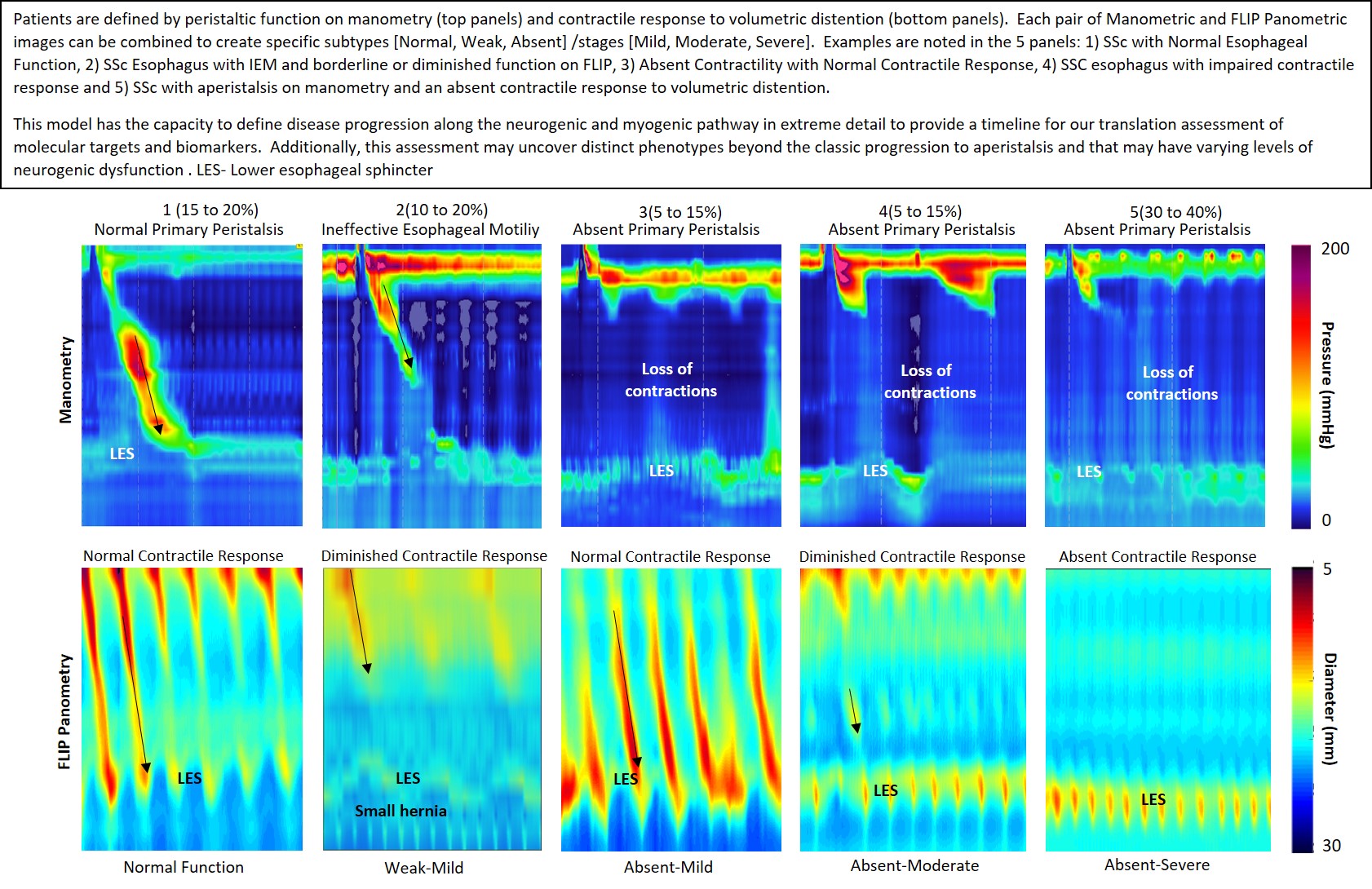Session Information
Date: Monday, November 8, 2021
Title: Systemic Sclerosis & Related Disorders – Clinical Poster II (1364–1390)
Session Type: Poster Session C
Session Time: 8:30AM-10:30AM
Background/Purpose: Although esophageal dysmotility is common in systemic sclerosis (SSc), little is known regarding the pathophysiology of the motor abnormalities driving reflux severity and dysphagia. This study aimed to assess primary and secondary peristalsis in SSc using a complementary approach focused on High-resolution manometry (HRM) and functional luminal imaging probe (FLIP) Panometry to provide a more comprehensive assessment of esophageal motility.
Methods: We performed simultaneous HRM and FLIP Panometry in 33 patients with SSc (28F, ages 38 to 77). Secondary peristalsis, i.e. contractile responses (CR), was classified on FLIP Panometry by presence and pattern of contractility as normal (NCR), borderline (BCR), impaired/disordered (IDCR), absent (ACR), or spastic-reactive (SRCR). Primary peristalsis on HRM was assessed according to the Chicago Classification. EGJ-distensibility index (EGJ-DI) was measured in all patients during FLIP-Panometry as a marker of LES function/opening.
Results: We were able to obtain complete data in 32 subjects as one patient had a sensor malfunction on FLIP. The manometric diagnoses were: Absent Contractility- 18 (56%); Ineffective Esophageal Motility- 7 (22%); Normal motility- 7 (22%). SSc patients also had heterogeneity in terms of secondary peristalsis with 38% (n=12) of patients having ACR, 38% (n=12) having IDCR, 19% (n=6) having BCR and 15% (n=5) having normal. The median (IQR) EGJ-DI was 5.8 mm2/mmHg (4.8-10.1) mm2/mmHg; 10/32 (31%) of the SSc patients had an EGJ-DI >8.0 mm2/mmHg and all 32 patients had an EGJ-DI >2.0 mm2/mmHg. Of the 18 patients that had absent contractility on HRIM; 11 (61%) patients had ACR, 5 (28%) had IDCR and 2 (11%) had BCR. Of the 7 patients with IEM, 1 patient had ACR, 1 patient had NCR and 5 had IDCR. All of the patients with Normal peristalsis had NCR or BCR. Based on these observations, a three tiered classification describing the relationship between findings on HRM and FLIP-Panometry is described in the Figure.
Conclusion: This was the first study to assess combined HRM and FLIP–Panometry in a cohort of SSc patients. Our results support heterogeneity in both primary and secondary peristalsis and a hierarchal classification scheme which can more accurately describe abnormalities of bolus transit.
 Subtypes of Esophageal Function in SSc defined by combined manometry/FLIP-panometry.
Subtypes of Esophageal Function in SSc defined by combined manometry/FLIP-panometry.
To cite this abstract in AMA style:
Pandolfino J, Perlman H, Hinchcliff M, Carns M, Pandolfino J, Pandolfino J, Correia C, Pandolfino J. Heterogeneity of Primary and Secondary Peristalsis in Systemic Sclerosis: A New Model of Scleroderma Esophagus [abstract]. Arthritis Rheumatol. 2021; 73 (suppl 9). https://acrabstracts.org/abstract/heterogeneity-of-primary-and-secondary-peristalsis-in-systemic-sclerosis-a-new-model-of-scleroderma-esophagus/. Accessed .« Back to ACR Convergence 2021
ACR Meeting Abstracts - https://acrabstracts.org/abstract/heterogeneity-of-primary-and-secondary-peristalsis-in-systemic-sclerosis-a-new-model-of-scleroderma-esophagus/
